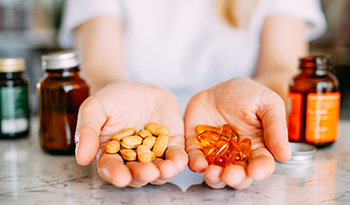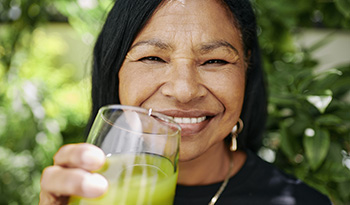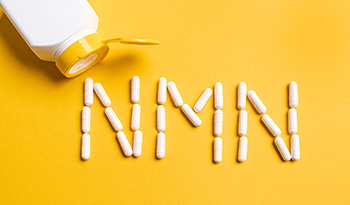Why Quercetin Is an Easy Choice for Antioxidant and Immune Support

Flavonoids are amazingly beneficial compounds from plants that promote human health. And of these compounds, quercetin shows the most potent effects, especially in fighting against aging and inflammation.
What Are Flavonoids?
Flavonoids are plant pigments primarily responsible for the colors of many fruits, flowers, and other foods. There are over 8,000 types of flavonoids identified.
Flavonoid molecules are the key factors responsible for the health benefits of berries, green tea, herbal extracts like Gingko and grapeseed, and superfoods like dark chocolate, acai, goji berries.
Since I first started studying human nutrition in the late 1970s, I have been fascinated by these compounds for their health benefits. And lately, the science of these compounds has been exploding with research, especially on quercetin.
Flavonoids have been called "nature's biological response modifiers." This term means that flavonoids can modify our biological response to disruptors, including inflammation, viruses, and allergens. And quercetin is the "alpha prime" of all flavonoids as it has been found to exert a wide range of beneficial actions on human gene expression and function.
Bioavailability of Curcumin and Quercetin
I am proud that in 1985, along with Terry Lemerond, I helped introduce quercetin into the health food industry as a dietary supplement. We also did the same for curcumin the very same year. Both quercetin and curcumin have become well-known natural products. They share some similarities but have more differences in how they work to promote health. Their market potential, i.e., the sales amount for each ingredient, should be about the same, but the popularity of curcumin has far exceeded that of quercetin. But that could change, and I will explain why.
In the last 40 years, there have been over 12,000 scientific investigations on the health benefits of curcumin, reflecting the scientific community's interest in understanding the unique ways curcumin could promote healthy function. Most of the studies on curcumin (and quercetin) have been "preclinical," meaning that the research focused on mechanisms of action and potential uses. Preclinical research sets the stage for human clinical trials. There have been about 300 human clinical trials with curcumin.
When researchers started studying curcumin in humans, they found that it was not absorbed very well or, in other words, it had low bioavailability. Since absorption is a significant factor in producing health benefits, regular curcumin powder did not show the same effects noted in the preclinical studies.
When I first introduced both quercetin and curcumin into the dietary supplement marketplace in 1985, I knew bioavailability would be an issue, so I combined it with the enzyme bromelain (from pineapple). Bromelain exerts many health benefits, but I combined it with these poorly absorbed molecules because there was substantial evidence that bromelain enhanced the absorption and tissue concentrations of similarly poorly absorbed molecules.
Curcumin slowly grew in popularity from 1985 to 2007 until researchers started studying the clinical benefits of better-absorbed forms of curcumin. That is when the exponential growth occurred in the sales of curcumin products. The results from clinical trials on these enhanced forms, such as Meriva® and Theracurmin®, were significantly better than regular curcumin powder because of their greater absorption/bioavailability. This research was the catalyst for increasing the awareness and popularity of curcumin for overall health goals such as improved brain and joint function, better mood scores, and reduced inflammation.1-4
The same results are finally happening for quercetin. Like curcumin, there have been numerous preclinical studies with quercetin—over 6,000 or a little more than half the number as curcumin. And the number of human clinical trials with quercetin (about 150) is also nearly half the number as curcumin.
Also, like curcumin, the human studies with regular quercetin were not as positive as the preclinical studies. But recent clinical trials with forms of quercetin enhanced for absorption and the results people are getting with these forms in products available in the marketplace have created a significant positive buzz about quercetin. Quercetin is expected to grow to a whopping $1.6 billion in annual sales by 2024. So, let's move on to discuss what quercetin can do and how to get the most from this valuable gift from nature.
Biological Properties of Quercetin
Discovery of Quercetin
Let's start at the beginning. Flavonoids and vitamin C were discovered by Albert Szent-Györgyi (1893–1986), who received the Nobel Prize in 1937 for his discoveries.
Szent-Györgyi discovered the flavonoids while isolating vitamin C from lemons. A friend with bleeding gums had stopped the bleeding by taking a crude vitamin C preparation isolated from lemons. When the problem reappeared, Szent-Györgyi gave his friend a purer form of vitamin C. He expected to observe an even more impressive result, but surprisingly the more refined form of vitamin C did not work. Szent-Györgyi then isolated the flavonoid fraction from the original crude vitamin C preparation, gave it to his friend, and observed complete healing.
The flavonoid extract was more effective in treating one of the significant signs of vitamin C deficiency (bleeding gums) than vitamin C was. In other words, the flavonoids, not the presumed active substance (vitamin C), were the actual active compounds in lemons. Szent-Györgyi termed his discovery "vitamin P" due to its ability to reduce vascular permeability, one of the hallmark features of scurvy (severe deficiency of vitamin C).
Szent-Györgyi went on to show that the clinical symptoms of scurvy are the result of a combined deficiency of vitamin C and vitamin P (flavonoids). However, because flavonoids could not fulfill all the vitamin D requirements, the designation as vitamin P was abandoned. Although flavonoids are not considered "essential" nutrients like vitamins, their importance to human health is equal to essential vitamins and minerals.
Quercetin and Collagen Structures
In addition to helping vitamin C do its job, quercetin increases intracellular levels of vitamin C. It also has many beneficial effects on capillary permeability and blood flow, primarily by strengthening the cells that compose capillaries (endothelial cells) and supporting collagen structures. Collagen, the most abundant protein of the body, is responsible for maintaining the integrity of the connective tissue that holds tissues together by forming the "ground substance" and the integrity of tendons, ligaments, and cartilage.
Quercetin and Lung Health
Quercetin is very important in supporting the lungs. Lung tissue is composed only of lung lining cells (epithelial cells), small blood vessels consisting of endothelial cells, and collagen-rich connective tissue. Lung tissue structure, function, and integrity are vitally dependent upon vitamin C and flavonoids, like quercetin. Flavonoids in general, and quercetin specifically, affect collagen in several ways, by:
- Reinforcing the natural cross-linking of collagen that forms the so-called collagen matrix of connective tissue.
- Inhibiting the breakdown of collagen during inflammation and infection.
- Preventing the formation and release of compounds that promote inflammation and tissue damage.
These benefits on collagen and capillaries make quercetin and other flavonoids especially important in supporting virtually every body tissue, not just the lungs.
Beyond Antioxidant Benefits
Although quercetin has shown some direct antioxidant effects in preclinical trials, it is unlikely that it happens in any significant way inside the human body.5,6 Another mechanism is responsible for its powerful impact in protecting cells from oxidative damage. Once absorbed into the body and individual cells, quercetin activates a cellular compound known as Nrf2. This compound, in turn, orchestrates a complex regulatory network that influences metabolism, inflammation, energy production within cells, and immune responses.
Interestingly, Nrf2 has been described as the "guardian of lifespan," as it protects the cell against damage, aging, and malfunction. Quercetin increases Nrf2 and helps it do its job in promoting cellular health, including the ability to increase antioxidant mechanisms.
Essentially, quercetin helps cells function better and exerts many beneficial effects, including an ability to preserve and restore the function of mitochondria (the energy-producing compartment of cells).7 By increasing energy production, the cell can function more optimally and regulate itself properly.
By improving mitochondrial function, quercetin can address one of the critical factors associated with the aging process—decreased mitochondrial function. In the brain, mitochondrial function is like a dimmer switch. When mitochondria produce enough energy, our brains are fully bright, but if the mitochondrial function is insufficient, it turns down the dimmer switch making us forgetful and "foggy."
Improving Mental and Physical Performance
Quercetin's effects on mitochondrial function are responsible for the positive results seen in several studies on improving mental/physical performance in athletes.8 However, the overall impact of regular quercetin powder on athletic performance was not all that significant.9 In contrast, more meaningful results were seen with a form of quercetin showing enhanced absorption. Specifically, in a study in triathletes, Quercetin Phytosome® at a dosage of 250 mg twice daily supplying a total daily dosage of 200 mg of quercetin was shown to improve performance time and reduce post-exercise muscular pain, cramps, and recovery time.10 These benefits were attributed to quercetin’s ability to significantly reduce oxidative stress and prevent red blood cells from breaking (hemolysis). The performance time after 14 days of Quercetin Phytosome® was decreased by 10.6% compared to 2.4% in the control group.
Relieving Allergies
Before the recent focus on improving immune health, the most popular use of quercetin has supported anti-allergy mechanisms. Considerable research shows that quercetin inhibits both the manufacture and release of histamine and other chemical mediators of allergies released by white blood cells known as mast cells and basophils.11
Mast cells are widely distributed throughout the human body but exist in higher concentrations just under the cells lining the respiratory tract, gastrointestinal tract, and skin. Basophils circulate in the blood.
Preclinical studies with quercetin improve the structure and function of mast cells and basophils, so they are not so reactive to stimuli. Quercetin also blocks the excessive manufacture of histamine and other chemical mediators.11
Quercetin and a modified form, EMIQ (enzymatically modified isoqueritrin), have beneficial effects in supporting people with seasonal allergic reactions.11,12 However, once again, these benefits pale compared to using Quercetin Phytosome®, an enhanced form of quercetin with improved bioavailability.
A study in Italy showed that when healthy subjects were given Quercetin Phytosome®, it blocked histamine release in the histamine challenge test. This led researchers to study Quercetin Phytosome® in 58 test subjects experiencing nasal and respiratory tract allergies. All subjects continued with their standard medical treatment, and either took 500 mg, 250 mg, or no Quercetin Phytosome®. Results showed clearly that Quercetin Phytosome® helped improve respiratory function, nasal irritation, and antioxidant status in the blood. It also led to decreased use of inhalers, nasal drops, and other medications.13
Antiviral Properties
There is a lot of current excitement on quercetin's antiviral activity in blocking virus entry into human cells or inhibiting the virus's ability to replicate. Blocking cell entry is just as crucial as inhibiting replication as viral entry is a required step to viral infection. Quercetin appears to excel at this aspect against respiratory tract viruses. By blocking entry, quercetin blocks infection.14
Quercetin also enhances the antiviral effects of ionic zinc. When zinc is not bound to other molecules in a free ionic state, it exerts significant action in blocking viruses from replicating. It does this by inhibiting an enzyme produced by the virus known as replicase. This enzyme is what a virus uses to reproduce itself within human cells. Quercetin acts as a zinc ionophore. It creates a channel in the cell wall that allows free ionic zinc to enter the infected cell and block viral replication.15
In terms of direct antiviral effects, quercetin inhibits several enzymes a virus needs to replicate. Co-administration with vitamin C produces better results and, in some cases, is vital to quercetin's antiviral effects.16 Vitamin C is also able to regenerate active quercetin in the body. Whenever an antioxidant performs its function in neutralizing a free radical, it is changed to an inactive form. In the case of quercetin, vitamin C can recycle it back into its active form. Therefore, vitamin C levels in the diet and supplementation must be adequate.
Quercetin (and vitamin C) also enhance interferon production. If you remember, interferon is the body's antiviral agent released by white blood cells (WBCs) to fight off viral infections. Quercetin enhances other WBC effects, including enhanced ability to move to areas of infection, kill infecting organisms, and increase the number of WBCs when needed.
Improving Immune Function
Francesco Di Pierro, MD, Ph.D., a world-leading expert in immunology and microbiology, conducted two clinical studies with an enhanced form of quercetin (Quercetin Phytosome®) in the early stages of acute viral respiratory tract infection.17,18
In the first study, 152 people with mild to moderate symptoms of an upper respiratory infection were treated with standard care alone or standard care plus 500 mg of Quercetin Phytosome® (providing 200 mg of quercetin) twice a day for 30 days. Results were highly positive. While 28.9% of people in the standard care group had to be hospitalized, only 9.2% of the quercetin group required hospitalization. This difference means that quercetin cut the hospitalization rate by 68%. And when the subjects taking the quercetin had to be hospitalized, the stay was much shorter. In the standard-care-only group, the average stay was 6.77 days versus only 1.57 days in the quercetin group. In addition, while 10.5% of the standard-care group progressed to a very severe condition that required admission to ICU and three of them died, no one on quercetin had to go to ICU, and none of them died.
In a second study, 42 people with mild to moderate symptoms of an upper respiratory infection were treated with standard care alone or standard care plus 500 mg of Quercetin Phytosome® (providing 200 mg of quercetin) three times a day for the first week and two times a day for the second. After one week, two people in the standard-care group tested negative, and four had their symptoms partially improved. In the quercetin group, 16 tested negative, and 12 had all their symptoms partially improved.
How to Choose Highly Absorbed Quercetin
Like curcumin, studies are showing some benefits with regular quercetin powder. But the results from clinical trials with Quercetin Phytosome® indicate that better-absorbed forms produce more consistent and higher blood levels. And that translates into superior results. The results from studies using enhanced forms of quercetin have fueled quercetin sales in the marketplace.
Two options are available on the marketplace.
- Quercetin Phytosome®, which is a complex of quercetin with sunflower lecithin (phosphatidylcholine).
- Quercetin LipoMicel Matrix™, which is a "nanoemulsion" composed of medium-chain triglycerides that surround and hold the quercetin in place at the center of a "micelle."
The clinical trials have been done with Quercetin Phytosome®. However, a detailed absorption study showed that 500 mg of quercetin as Quercetin LipoMicel Matrix™ produces equal total absorption. Still, higher peak levels than 500 mg of quercetin as Quercetin Phytosome®.19 When forms show the same blood levels, they are termed "bioequivalent."
As far as what 500 mg of quercetin from these two enhanced forms translates to in terms of regular quercetin powder, it is at least a factor of 10-fold absorption advantage for Quercetin Phytosome® and Quercetin LipoMicel Matrix™.19,20 So, 500 mg of actual quercetin translates to approximately 5,000 mg of quercetin powder for either of the enhanced forms.
In terms of how Quercetin Phytosome® and Quercetin LipoMicel Matrix™ compare practically, some math must be used to calculate dosage (and cost) between the two forms since the actual quercetin content is 40% of the total amount of Quercetin Phytosome®. At the same time, it is expressed as the actual quercetin content with the Quercetin LipoMicel Matrix™. To put this difference in context, a 250 mg capsule of Quercetin Phytosome® supplies 100 mg of quercetin. In contrast, the Quercetin LipoMicel Matrix™ contains 250 mg of quercetin per capsule.
The studies with Quercetin Phytosome® during an acute viral infection used a dosage of 500 mg (providing 200 mg quercetin) two to three times daily. To translate that dosage into the Quercetin LipoMicel Matrix™ form, since each capsule contains 250 mg quercetin, the dosage would be one 250 mg capsule two to three times daily. Again, 500 mg of quercetin from either advanced form would be equal to at least 5,000 mg of regular quercetin powder.
References:
- Mirzaei H, Shakeri A, Rashidi B, Jalili A, Banikazemi Z, Sahebkar A. Phytosomal curcumin: A review of pharmacokinetics, experimental and clinical studies. Biomed Pharmacother. 2017;85:102-112.
- Belcaro G, Cesarone MR, Dugall M, et al. Efficacy and safety of Meriva®, a curcumin-phosphatidylcholine complex, during extended administration in osteoarthritis patients. Altern Med Rev. 2010;15(4):337-344.
- Nakagawa Y, Mukai S, Yamada S, et al. Short-term effects of highly-bioavailable curcumin for treating knee osteoarthritis: a randomized, double-blind, placebo-controlled prospective study. J Orthop Sci. 2014;19(6):933-939.
- Small GW, Siddarth P, Li Z, et al. Memory and Brain Amyloid and Tau Effects of a Bioavailable Form of Curcumin in Non-Demented Adults: A Double-Blind, Placebo-Controlled 18-Month Trial. Am J Geriatr Psychiatry. 2018;26(3):266-277.
- Xu D, Hu MJ, Wang YQ, Cui YL. Antioxidant Activities of Quercetin and Its Complexes for Medicinal Application. Molecules. 2019;24(6):1123.
- Batiha GE, Beshbishy AM, Ikram M, et al. The Pharmacological Activity, Biochemical Properties, and Pharmacokinetics of the Major Natural Polyphenolic Flavonoid: Quercetin. Foods. 2020;9(3):374.
- de Oliveira MR, Nabavi SM, Braidy N, Setzer WN, Ahmed T, Nabavi SF. Quercetin and the mitochondria: A mechanistic view. Biotechnol Adv. 2016;34(5):532-549.
- MacRae HS, Mefferd KM. Dietary antioxidant supplementation combined with quercetin improves cycling time trial performance. Int J Sport Nutr Exerc Metab. 2006;16(4):405-419.
- Pelletier DM, Lacerte G, Goulet ED. Effects of quercetin supplementation on endurance performance and maximal oxygen consumption: a meta-analysis. Int J Sport Nutr Exerc Metab. 2013;23(1):73-82.
- Riva A, Vitale JA, Belcaro G, et al. Quercetin phytosome® in triathlon athletes: a pilot registry study. Minerva Med. 2018 Aug;109(4):285-289.
- .Jafarinia M, Sadat Hosseini M, Kasiri N, et al. Quercetin with the potential effect on allergic diseases. Allergy Asthma Clin Immunol. 2020;16:36.
- Kawai M, Hirano T, Arimitsu J, et al. Effect of enzymatically modified isoquercitrin, a flavonoid, on symptoms of Japanese cedar pollinosis: a randomized double-blind placebo-controlled trial. Int Arch Allergy Immunol 2009;149:359–368.
- Cesarone MR, Belcaro G, Hu S, et al. Supplementary prevention and management of asthma with quercetin phytosome: a pilot registry. Minerva Med. 2019;110(6):524-529.
- Di Petrillo A, Orrù G, Fais A, Fantini MC. Quercetin and its derivates as antiviral potentials: A comprehensive review. Phytother Res. 2022;36(1):266-278.
- Dabbagh-Bazarbachi H, Clergeaud G, Quesada IM, et al. Zinc ionophore activity of quercetin and epigallocatechin-gallate: from Hepa 1-6 cells to a liposome model. J Agric Food Chem. 2014 Aug 13;62(32):8085-93.
- https://www.ncbi.nlm.nih.gov/pmc/articles/PMC7318306/
- https://pubmed.ncbi.nlm.nih.gov/34135619/
- https://www.ncbi.nlm.nih.gov/pmc/articles/PMC8238537/
- Soldier J, Chang C, Roh K et al. Quercetin LipoMicel—A Novel Delivery System to Enhance Bioavailability of Quercetin. J Nat Health Prod Res. 2021;3(2):1-.
- Riva A, Ronchi M, Petrangolini G, Bosisio S, Allegrini P. Improved Oral Absorption of Quercetin from Quercetin Phytosome®, a New Delivery System Based on Food Grade Lecithin. Eur J Drug Metab Pharmacokinet. 2019;44(2):169-177.
DISCLAIMER:This Wellness Hub does not intend to provide diagnosis...













































































 Table of Contents
Table of Contents















